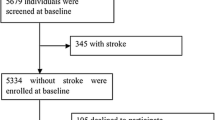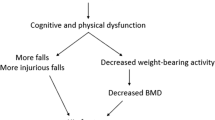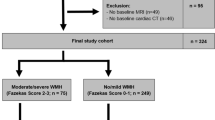Abstract
Summary
Previous studies have not demonstrated a relationship between osteoporosis and cerebral infarction in the community, especially in men. We found that osteoporosis may be an independent risk factor for brain white matter change/silent infarction in men, as well as in women.
Purpose
We aimed to study the relationship between low bone mineral density (BMD) and brain white matter changes and/or silent infarcts (WMC/SI).
Methods
This was a community-based, cross-sectional study supported by the regional government. Bone mineral density measurements and brain computed tomography were performed in 646 stroke- and dementia-free subjects (aged 50–75 years).
Results
After adjustment for age, hypertension, diabetes mellitus, dyslipidemia, and current smoking status, the odds ratio (OR) of risk for WMC and/or SI was 1.8 in the osteopenia group (95 % confidence interval [CI] 1.15–2.77; P = 0.01) and 2.2 in the osteoporosis group (95 % CI 1.42–3.55; P < 0.001). Among men, the OR was 1.8 (95 % CI 0.72–4.62; P = 0.21) and 3.8 (95 % CI 1.63–8.86; P = 0.002), and in women, the OR was 1.9 (95 % CI 1.15–2.78; P = 0.010) and 2.2 (95 % CI 1.42–3.55; P = 0.001), respectively.
Conclusions
Severe bone mass loss may be an independent risk factor for brain WMC/SI in men and women. Low BMD may cause brain WMC/SI in the step that leads to stroke. Although there are well-designed studies on the prevention of cerebral infarction in patients with brain WMC/SI, a specific prevention method, such as aspirin, should be used for patients with low BMD who have WMC/SI. Screening for low BMD as an independent vascular risk factor in healthy subjects may be required to prevent stroke.

Similar content being viewed by others
References
Aronow WS (2011) Osteoporosis, osteopenia, and atherosclerotic vascular disease. Arch Med Sci 7:21–26
Baldini V, Mastropasqua M, Francucci CM, D'Erasmo E (2005) Cardiovascular disease and osteoporosis. J Endocrinol Invest 28:69–72
Lampropoulos CE, Papaioannou I, D’Cruz DP (2012) Osteoporosis—a risk factor for cardiovascular disease? Nat Rev Rheumatol 8:587–598
Nordström A, Eriksson M, Stegmayr B, Gustafson Y, Nordström P (2010) Low bone mineral density is an independent risk factor for stroke and death. Cerebrovasc Dis 29:130–136
Browner WS, Pressman AR, Nevitt MC, Cauley JA, Cummings SR (1993) Association between low bone density and stroke in elderly women. The study of osteoporotic fractures. Stroke 24:940–946
Stojanovic OI, Lazovic M, Vuceljic M (2011) Association between atherosclerosis and osteoporosis, the role of vitamin D. Arch Med Sci 7:179–188
Price PA, Faus SA, Williamson MK (2001) Bisphosphonates alendronate and ibandronate inhibit artery calcification at doses comparable to those that inhibit bone resorption. Arterioscler Thromb Vasc Biol 21:817–824
Mussolino ME, Gillum RF (2008) Low bone mineral density and mortality in men and women: the third national health and nutrition examination survey linked mortality file. Ann Epidemiol 18:847–850
Myint PK, Clark AB, Kwok CS et al (2014) Bone mineral density and incidence of stroke. European prospective investigation into cancer-Norfolk population-based study, systematic review, and meta-analysis. Stroke 45:373–382
Minn YK, Suk SH, Park H, Cheong JS, Yang H, Lee S, Do SY, Kang JS (2013) Tooth loss is associated with brain white matter change and silent infarction among adults without dementia and stroke. J Korean Med Sci 28:929–933
Chobanian AV, Bakris GL, Black HR et al (2003) The seventh report of the Joint National Committee on prevention, detection, evaluation, and treatment of high blood pressure: the JNC 7 report. JAMA 289:2560–2572
National Cholesterol Education Program Expert Panel on Detection E, Treatment of High Blood Cholesterol in A (2002) Third report of the national cholesterol education program (NCEP) Expert panel on detection, evaluation, and treatment of high blood cholesterol in adults (Adult treatment panel III) final report. Circulation 106:3143–3421
Report of the Expert Committee on the Diagnosis and Classification of Diabetes Mellitus (2003) Report of the expert committee on the diagnosis and classification of diabetes mellitus. Diabetes care 26 Suppl 1:S5-20
Giele JL, Witkamp TD, Mali WP, van der Graaf Y (2004) Silent brain infarcts in patients with manifest vascular disease. Stroke 35:742–746
Wahlund LO, Barkhof F, Fazekas F et al (2001) A new rating scale for age-related white matter changes applicable to MRI and CT. Stroke 32:1318–1322
Genant HK, Cooper C, Poor G et al (1999) Interim report and recommendations of the World Health Organization Task-Force for Osteoporosis. Osteoporos Int 10:259–264
Tamaki J, Iki M, Hirano Y, Sato Y, Kajita E, Kagamimori S, Kagawa Y, Yoneshima H (2009) Low bone mass is associated with carotid atherosclerosis in postmenopausal women: the Japanese Population-Based Osteoporosis (JPOS) cohort study. Osteoporos Int 20:53–60
Nelson HD, Haney EM, Chou R, Dana T, Fu R, Bougatsos C (2010) Screening for osteoporosis: systematic review to update the 2002 U.S. preventive services task force recommendation. Rockville MD
U.S. Preventive Services Task Force (2002) Screening for osteoporosis in postmenopausal women: recommendations and rationale. Ann Intern Med 137:526–528
Nayak S, Olkin I, Liu H, Grabe M, Gould MK, Allen IE, Owens DK, Bravata DM (2006) Meta-analysis: accuracy of quantitative ultrasound for identifying patients with osteoporosis. Ann Intern Med 144:832–841
Diaz R (2010) Pharmacotherapy: increased stroke risk associated with osteoporosis drugs. Nat Rev Endocrinol 6:472
Bolland MJ, Grey A, Avenell A, Gamble GD, Reid IR (2011) Calcium supplements with or without vitamin D and risk of cardiovascular events: reanalysis of the women’s health initiative limited access dataset and meta-analysis. BMJ 342:d2040
Mosca L, Grady D, Barrett-Connor E et al (2009) Effect of raloxifene on stroke and venous thromboembolism according to subgroups in postmenopausal women at increased risk of coronary heart disease. Stroke 40:147–155
Vestergaard P, Schwartz K, Pinholt EM, Rejnmark L, Mosekilde L (2011) Stroke in relation to use of raloxifene and other drugs against osteoporosis. Osteoporos Int 22:1037–1045
Kobayashi S, Okada K, Koide H, Bokura H, Yamaguchi S (1997) Subcortical silent brain infarction as a risk factor for clinical stroke. Stroke 28:1932–1939
Bernick C, Kuller L, Dulberg C, Longstreth WT Jr, Manolio T, Beauchamp N, Price T (2001) Silent MRI infarcts and the risk of future stroke: the cardiovascular health study. Neurology 57:1222–1229
Vermeer SE, Hollander M, van Dijk EJ, Hofman A, Koudstaal PJ, Breteler MM (2003) Silent brain infarcts and white matter lesions increase stroke risk in the general population: the Rotterdam Scan Study. Stroke 34:1126–1129
Cardiovascular Health Study Collaborative Research G, Kuller LH, Longstreth WT Jr, Arnold AM, Bernick C, Bryan RN, Beauchamp NJ Jr (2004) White matter hyperintensity on cranial magnetic resonance imaging: a predictor of stroke. Stroke 35:1821–1825
Sacco RL, Kasner SE, Broderick JP et al (2013) An updated definition of stroke for the 21st century: a statement for healthcare professionals from the american heart association/american stroke association. Stroke 44:2064–2089
Feng C, Bai X, Xu Y, Hua T, Liu X-Y (2013) The ‘silence’ of silent brain infarctions may be related to chronic ischemic preconditioning and nonstrategic locations rather than to a small infarction size. Clinics 68:365–369
Weber R, Weimar C, Wanke I et al (2012) Risk of recurrent stroke in patients with silent brain infarction in the Prevention Regimen for Effectively Avoiding Second Strokes (PRoFESS) imaging substudy. Stroke 43:350–355
Skoog I, Palmertz B, Andreasson LA (1994) The prevalence of white-matter lesions on computed tomography of the brain in demented and nondemented 85-year-olds. J Geriatr Psychiatry Neurol 7:169–175
Goldstein LB, Bushnell CD, Adams RJ et al (2011) Guidelines for the primary prevention of stroke: a guideline for healthcare professionals from the American Heart Association/American Stroke Association. Stroke 42:517–584
Goldstein LB, Adams R, Becker K et al (2001) Primary prevention of ischemic stroke: a statement for healthcare professionals from the stroke council of the American heart association. Stroke 32:280–299
Acknowledgments
This study was supported by Ansan City, Gyeonggi Province, Korea
Ethics statement
The study protocol was reviewed and approved by the institutional review board of Wonkwang University Hospital (IRB no. 1425).
Conflicts of interest
None.
Author information
Authors and Affiliations
Corresponding author
Rights and permissions
About this article
Cite this article
Minn, Y.K., Suk, S.H. & Do, S.Y. Osteoporosis as an independent risk factor for silent brain infarction and white matter changes in men and women: the PRESENT project. Osteoporos Int 25, 2465–2469 (2014). https://doi.org/10.1007/s00198-014-2785-3
Received:
Accepted:
Published:
Issue Date:
DOI: https://doi.org/10.1007/s00198-014-2785-3




